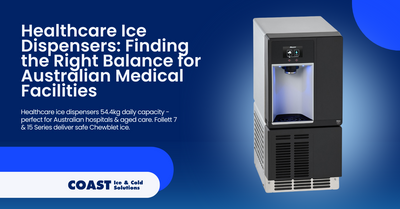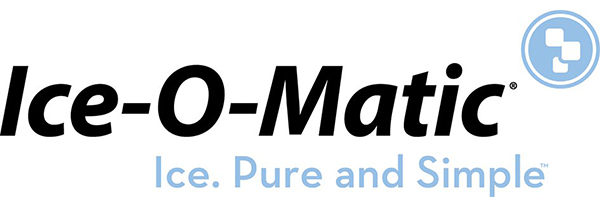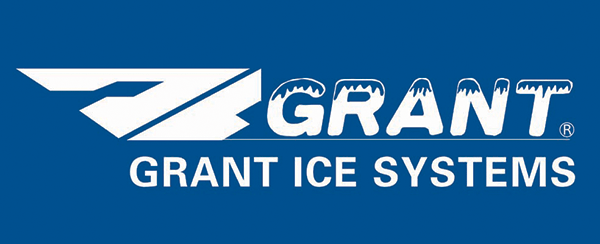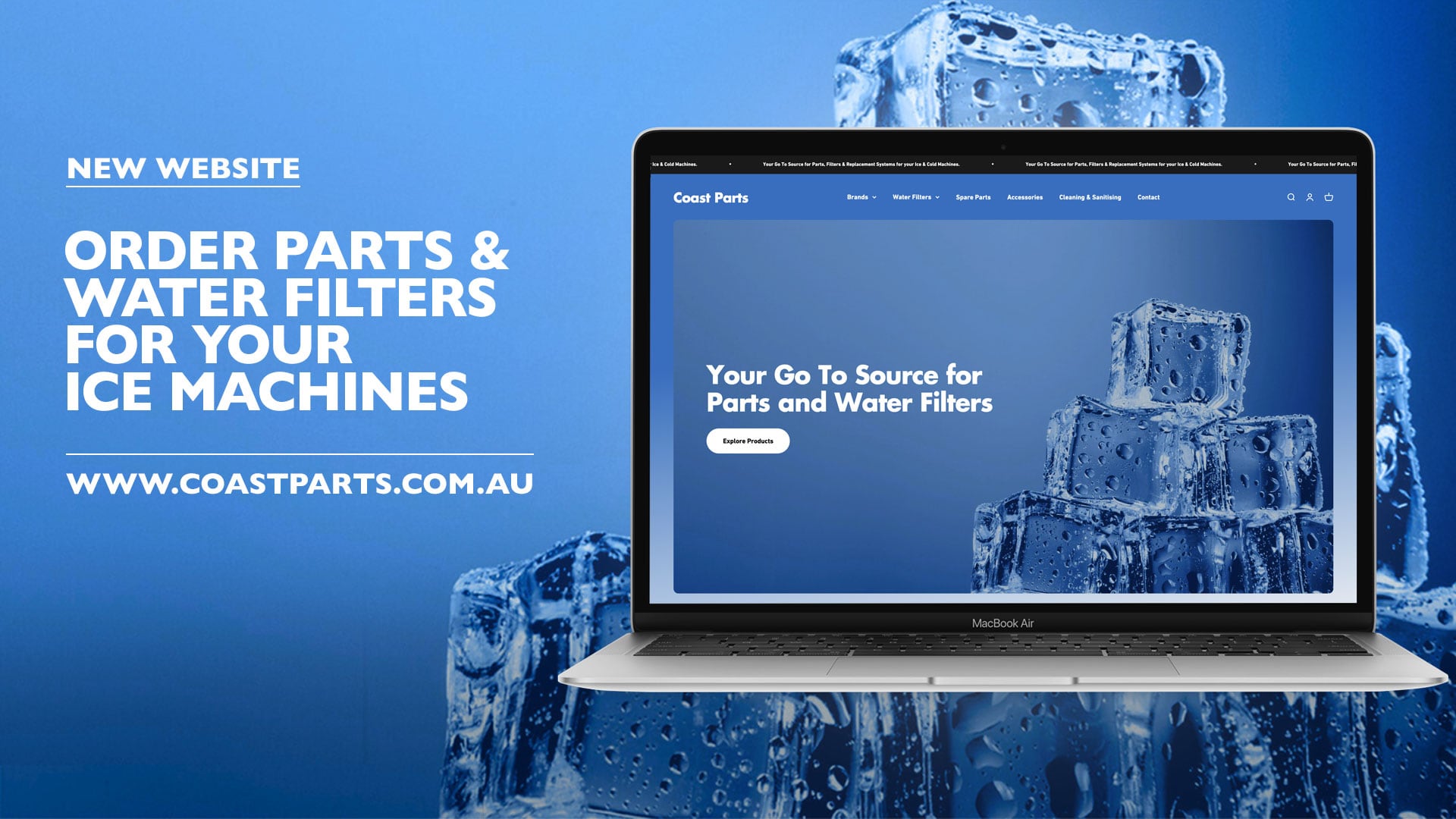Healthcare Ice Dispensers 54.4kg Daily Capacity: Finding the Right Balance for Australian Medical Facilities
The Coast Team on 24th Jul 2025
It's 2 AM at a busy Brisbane hospital, and the nurse on duty needs ice for a patient recovering from oral surgery. She walks to the ice machine only to find it's empty – again. The unit can't keep up with demand, and staff are constantly waiting for it to refill. If you're managing ice supply in an Australian healthcare facility, you've likely faced this exact scenario.
Healthcare ice dispensers with 54.4kg daily capacity hit that sweet spot between oversized commercial units and inadequate undercounter models. They're particularly suited to Australian medical facilities where space comes at a premium but reliable ice supply remains critical for patient care.
Why 54.4kg Daily Capacity Makes Sense for Australian Healthcare Settings
Let's talk numbers. A typical 30-bed ward in a Sydney private hospital might use between 40-60kg of ice daily, depending on the season and patient mix. Factor in our scorching summers – when Melbourne can hit 40°C and Perth regularly sees weeks above 35°C – and ice consumption can spike dramatically.
The Follett E7CI114A produces up to 54.4kg in a 24-hour period with 3.2kg storage capacity, matching these real-world demands without the excess capacity that leads to stale ice and wasted energy. You're not paying to cool ice that sits unused, and you're not dealing with the maintenance headaches of oversized equipment.
Think about your facility's ice usage patterns. Most healthcare ice consumption happens during:
- Morning medication rounds (8-10 AM)
- Lunch service (12-2 PM)
- Evening shift changes (6-8 PM)
- Emergency admissions (unpredictable)
A 54.4kg capacity unit handles these peaks while recovering between rushes. The key is matching production to consumption – too little and you're constantly out; too much and you're wasting money on equipment and energy.
Understanding Chewblet Ice: Why Healthcare Facilities Are Making the Switch
If you've worked in healthcare long enough, you've probably dealt with traditional cube ice causing problems. Hard cubes are a choking hazard for elderly patients, difficult for post-surgical patients to manage, and frankly, a pain for staff to portion correctly.
Chewblet ice – that compressed nugget ice Follett pioneered – solves these issues elegantly. The Follett 7 & 15 Series produce ice that's soft enough for patients to chew safely but firm enough to cool beverages effectively. Each piece is roughly the size of a small pill, making it ideal for:
- Dysphagia patients who need carefully controlled textures
- Post-dental surgery recovery
- Paediatric wards where smaller ice pieces reduce choking risks
- Aged care facilities throughout Australia
The ice also displaces better in cups, meaning you use less per serving while maintaining the same cooling effect. In a healthcare setting where every dollar counts, that efficiency matters.
Meeting Australian Healthcare Standards with Ice Equipment
Here's where things get serious. The Therapeutic Goods Administration (TGA) and Food Standards Australia New Zealand (FSANZ) don't mess around when it comes to ice safety in healthcare settings. Your ice is classified as a food product, and in medical environments, it's often going directly into patients' mouths.
Modern healthcare ice dispensers incorporate antimicrobial treatments – something Coast Distributors specifically mentions for their Follett units. This helps inhibit bacterial growth between cleanings, though it doesn't replace proper sanitisation procedures.
When selecting ice equipment for healthcare, you need to consider:
- How easy is it to clean and sanitise?
- Can staff access all surfaces that contact ice?
- Does the design prevent contamination during dispensing?
- Are the materials suitable for healthcare-grade cleaning chemicals?
The reality is that infection control officers will scrutinise any new ice equipment, so choosing units designed with healthcare in mind saves headaches down the track.
Space Constraints in Australian Healthcare: Countertop vs Undercounter vs Freestanding
Australian hospitals aren't getting bigger, but patient loads certainly are. If you're retrofitting ice equipment into an existing nurses' station or medication room, every centimetre matters. This is where the different configurations of 54.4kg units become crucial.
Countertop Units like the Follett E7CI114A:
- Ideal for nurses' stations with existing bench space
- Easy access for staff of all heights
- Simple installation – just needs power and water
- Takes up valuable bench space that might be needed for other equipment
Undercounter Units like the Follett E7UC114A:
- Maximises vertical space usage
- Keeps benchtops clear for other tasks
- Can be harder for shorter staff to access
- Requires proper ventilation space beneath counters
Freestanding Units like the Follett E15FS114A:
- Most flexible placement options
- Larger storage capacity (6.8kg vs 3.2kg)
- Requires dedicated floor space
- Easier to relocate if ward layouts change
Consider where you'll place these units. A busy emergency department in Darwin might benefit from the larger storage of a freestanding unit, while a compact nurses' station in an older Melbourne hospital might only have room for an undercounter model.
Real-World Considerations for Australian Healthcare Facilities
Let's get practical about what actually matters when you're selecting ice equipment for healthcare in Australia.
Water Quality Varies Dramatically: Sydney's water is relatively soft, while Adelaide deals with some of the hardest water in the country. Hard water causes scale buildup that can destroy ice machine efficiency and create maintenance nightmares. Whatever unit you choose, factor in appropriate water filtration – it's not optional in most Australian cities.
Ambient Temperature Matters: A unit that works perfectly in an air-conditioned Hobart hospital might struggle in a Darwin facility where ambient temperatures regularly exceed 30°C. The 54.4kg production capacity assumes reasonable operating conditions – push beyond those and production drops.
Distance from Patients: In sprawling regional hospitals, centralised ice production means staff waste time walking back and forth. Sometimes multiple smaller units make more sense than one large machine. The 54.4kg capacity units are small enough to distribute throughout a facility while large enough to meet localised demand.
Staffing Realities: Your ice equipment needs to work for everyone from experienced nurses to casual agency staff. Complicated controls or high-maintenance units create problems when you're already stretched thin. Simple operation matters as much as production capacity.
Installation Planning for Healthcare Ice Equipment
Installing ice equipment in a healthcare setting involves more complexity than dropping a unit into a café. You're dealing with strict plumbing codes, infection control requirements, and the reality that you can't have extended downtime in a working hospital.
Before committing to any 54.4kg unit, verify:
- Electrical capacity at the installation site
- Water pressure and connection points
- Drainage requirements and backflow prevention
- Ventilation and heat dissipation
- Access for cleaning and maintenance
- Compliance with local health department regulations
Many older Australian hospitals have electrical systems that haven't been updated in decades. That beautiful heritage building in suburban Brisbane might need electrical work before it can support modern ice equipment. Factor these costs into your budget from the start.
The Economics of Ice in Healthcare Settings
Healthcare facilities operate on tight budgets, and every equipment decision faces scrutiny. When evaluating 54.4kg capacity units, consider the total cost equation:
Direct Costs:
- Purchase price of the unit
- Installation including any required infrastructure upgrades
- Water filtration systems
- Ongoing maintenance and cleaning supplies
- Energy consumption
- Water usage and drainage charges
Indirect Benefits:
- Reduced staff time fetching ice from distant locations
- Improved patient satisfaction with appropriate ice texture
- Lower infection risk with antimicrobial treatments
- Reduced waste from overproduction
- Better hydration compliance among elderly patients
The Follett E15FS114A with its 6.8kg storage capacity might cost more initially but could reduce the frequency of ice outages during peak times. That matters when nurse satisfaction and patient care are on the line.
Maintenance Realities in Busy Healthcare Environments
You can't take an ice machine offline for maintenance during peak hours in a hospital. That's reality. Any 54.4kg unit you choose needs to accommodate the maintenance constraints of 24/7 healthcare operations.
Key maintenance considerations:
- How quickly can routine cleaning be completed?
- Are replacement parts readily available in Australia?
- Can basic maintenance be performed by facility staff?
- What's the typical response time for service calls?
Coast Distributors operates throughout Australia, which matters when you need service support. There's nothing worse than waiting days for a technician to fly in from interstate when your ice machine goes down.
Special Considerations for Different Healthcare Settings
Not all healthcare facilities have the same ice needs, even with similar bed counts. Let's look at how different settings might use 54.4kg capacity units:
Acute Care Hospitals: Need reliable ice supply 24/7 with minimal downtime. The antimicrobial treatment in Follett units provides an extra safety margin for immunocompromised patients. Consider placing units in each ward rather than centralising supply.
Aged Care Facilities: Chewblet ice encourages hydration among elderly residents who struggle with traditional cubes. The softer texture reduces choking risk – a serious concern in dementia units. Multiple smaller units often work better than centralised systems.
Day Surgery Centres: Predictable schedules mean you can plan ice production around patient flow. A single 54.4kg unit might suffice for a 10-bed facility, especially with the larger 6.8kg storage of the 15 Series.
Rehabilitation Centres: Ice serves dual purposes – hydration and therapy. The consistent texture of Chewblet ice works well for both applications. Consider placement near therapy areas as well as patient wards.
Future-Proofing Your Healthcare Ice Solution
Healthcare delivery in Australia continues evolving. When investing in ice equipment, think beyond immediate needs:
Changing Demographics: Australia's ageing population means more patients with swallowing difficulties. Chewblet ice addresses this growing need better than traditional cubes.
Sustainability Focus: Healthcare facilities increasingly track environmental impact. Energy-efficient equipment aligns with these goals while reducing operating costs.
Infection Control Evolution: Post-COVID, infection control standards keep tightening. Equipment with built-in antimicrobial features positions you ahead of regulatory changes.
Space Optimisation: As healthcare facilities maximise every square metre, compact equipment that doesn't compromise capacity becomes increasingly valuable.
Making the Decision: Which Configuration Works for You?
Choosing between countertop, undercounter, and freestanding 54.4kg units depends on your specific situation:
Choose Countertop (E7CI114A) when:
- You have adequate bench space
- Easy access for all staff is priority
- Installation simplicity matters
- You need portable options
Choose Undercounter (E7UC114A) when:
- Bench space is at a premium
- You're retrofitting existing spaces
- Aesthetics matter (hidden equipment)
- You have adequate undercounter ventilation
Choose Freestanding (E15FS114A) when:
- You need maximum storage capacity
- Flexibility in placement is important
- You have dedicated equipment areas
- Higher volume dispensing is required
Remember, all produce the same 54.4kg daily capacity – the difference lies in storage and installation flexibility.
Ready to upgrade your healthcare facility's ice supply with reliable 54.4kg daily capacity? Contact Coast Distributors to discuss which Follett dispenser suits your medical facility needs:
- View the Follett E7CI114A Countertop specifications
• View the Follett E7UC114A Undercounter specifications
• View the Follett E15FS114A Freestanding specifications
• Explore our complete range of 7 & 15 Series healthcare ice solutions
• Speak with our expert team by filling out our contact form
• Need a service for your machine: fill out our service request form
• Need water filters or spare parts? Browse our parts inventory
Don't let inadequate ice supply compromise your patient care standards. Join the growing number of Australian healthcare facilities already benefiting from properly sized Chewblet ice systems. Coast Distributors is Australia's exclusive Follett distributor, providing healthcare ice solutions nationwide. With 24-hour service support and extensive medical facility experience, we ensure your ice equipment supports optimal patient outcomes. Visit coastdistributors.com.au to learn more.









